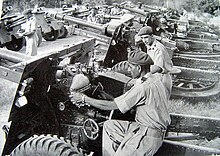Chamb, Azad Kashmir
The Pakistan Army has built its infrastructure in Chumb. Most people's languages are Pahari-Pothwari and Punjabi. Chumb is also known as Iftikharabad due to Maj General Iftikhar Khan Janjua who played a key role in liberating Chumb. It is divided into two parts South Iftikharabad and North Iftikharabad. There is only one police station (Singry).
Chumb sector was under Indian control until the War of 1971, when the Pakistan Army regained the area. Chumb is the last outpost of Pakistan's Azad Kashmir. Chumb has fertile land and farmlands can be found here.
History
1965 War

Chumb came under the Indian side as per the 1949 cease-fire agreement. During the Indo-Pakistani War of 1965, the Pakistani troops invaded the Chhamb-Jaurian sector of Indian-administered Kashmir as part of Operation Grand Slam, making significant gains and capturing Chumb. However, the status quo ante was reestablished in the Tashkent Agreement.
1971 War

The Pakistan Army made another attempt to capture this strategically important area and invaded Chumb on the same principles as it invaded in 1965. The reason behind this plan was to deter Indians from attacking the crucial north–south line of communications passing via Gujrat. The fighting around Chamb was intensely fierce and took a toll on both the advancing Pakistani troops and the Indian regiments. On 9 December 1971, the first Pakistani troops entered the surrounding area around Chumb under the personal supervision of Maj General Iftikhar Khan Janjua.

A memorial of Major General Iftikhar Khan Janjua is located in Chumb where his helicopter crashed during the battle. He was immediately evacuated to CMH Kharian, but could not survive the wounds and succumbed- just days before Chhamb was captured. He was awarded the Hilal-e-Jurat.
The Chumb sector had a population of around 10,000 people at the time it was captured. The area became a ghost town as most of its residents fled to India following the Pakistani takeover.
Since 1971
In 2020, Gen Bajwa visited the Chhamb sector and emphasised upon troops to extend all-out support to local population affected by ceasefire violations.
Education
A Boys College (Kherowal), a Girls College (Dingawali), a Boys High School (Porre), and a Girls High School (Punjgran) are located here. The people who belong to the south are Punjabi and the north is mostly Paharis and Gujjars from Rajauri. It is agricultural land. The people are mostly farmers. The members of the Chackmerry community in Chhamb are descendants of early Gujjar settlers who had arrived here from Rajauri in India.
References
- ^ Naqash, Tariq (2018-04-26). "2 killed in AJK due to cross-LoC firing by Indian troops". Retrieved 2021-09-15.
The Chamb sector is located in Barnala tehsil of Bhimber, the southernmost AJK district which runs along the heavily militarised LoC splitting the disputed Himalayan region of Kashmir between Pakistan and India.
- ^ Naqash, Tariq (2016-11-16). "200 families hit by Indian shelling move to safe areas". Retrieved 2021-09-15.
Divisional Commissioner Raja Amjad Pervaiz said displacements had taken place from Balewal and Khairowal villages of the Chhamb (Iftikharabad) sector of Barnala tehsil.
- ^ Kamm, Henry (1971-12-13). "Pakistani Forces Take Ghost Town in Kashmir". The New York Times. Retrieved 2021-09-13.
Chhamb, a comfortable looking town that normally has perhaps 10,000 people, was seized by the Pakistani Army last Tuesday, after fierce fighting on the defensive lines protecting it.
- ^ "COAS Bajwa visits Chamb Sector along LoC".